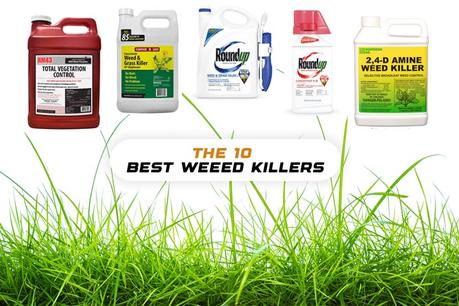
Weeds are unwanted plants, no matter how many times you pluck them out, somehow they always pop right back up. They not only make your yard look un-kept and messy, but they also compete with neighboring plants for vital nourishments like water, sunlight, and nutrients making the nearby plants weak and exposed to dangerous pesticides.
Fortunately, there are many effective solutions available in the market today. Weed killers are the best long-term solution for tackling the issue of weeds for months and sometimes even a year.
Weed killers (herbicides) are extremely effective in handling dandelions, crabgrass, chickweeds and other common weeds.In this article, we will discuss and share some of the most effective and best weed killer products that will help you get rid of weeds in the long term.
The Best Weed Killers
09. Fast Acting Vegetation Killer: Roundup Weed & Grass Killer Concentrate Plus
Weed Killers Buying Guide
Three things you should consider before buying weed KillerTemporary vs. Long-Lasting
If you are looking to remove weeds from your garden for a short period of time then temporary weed killers are the way to go. They are very useful because they stay in the soil for only a few days and if need to plant some seeds that will be fine. Long-term weed killers will keep weeds from growing for many months even a year in some cases however they will not let any seeds germinate in the area where the product is sprayed.
Selective vs. non-selective
Non-selective weed killers are developed to control a broad range of weeds. Whereas selective weed killers are made to control specific weeds. They can be toxic for some plants.
Pre-emergent and Post-emergent
There are two types of herbicides used for different growth stages of the weed, Pre-emergent and Post-emergent. Pre-emergent weed killers are used to preventing weeds from sprouting altogether. However, post-emergent weed killers are to be used after the weed has developed.
Types of Weeds
Weeds can easily be identified through their easily recognizable characteristics. For instance, they are invasive, have quick seed production, are competitive with surrounding plants, etc. To be able to eliminate weeds and select proper types of weed killers, you first have to understand what type of weed it is, so that you can find a solution that will be able to do the job of eradicating it.
Various types of weeds can grow on any lawn, Grassy weeds such as crabgrass, quack grass, and broadleaf plantain, thistle, dandelions, dollarweed, and oxalis. These fall into the three life cycles of weeds referred to as annual, biennial, and perennial weeds.
Annual vs. Perennial weeds
All annual life cycle weeds germinate from seeds.
There are two types of annual weeds. The first type germinates in the soil when the temperatures are warm enough, probably around early summer or late spring and the other type germinates throughout the summer when the conditions are adequate.
Perennial weeds can either produce through seeds or their energy and nutrients, storing parts like roots and tubers. These are unique because they can reproduce their entire plant through a small stem or a root. This type can survive for more than a year because of its energy reservoir that helps them survive for a long time. The perennial cycle starts in spring, but its end can vary on the amount of energy being stored and the amount of seed production.
Annual Weeds
Crabgrass
Crabgrass is an annual weed that grows in grass that is malnourished, weak, and thin. Crabgrass usually germinates in late spring when the temperature of the soil at a 2-inch depth reaches around 55°F. During summer the crabgrass starts to develop into a ground-hugging weed that quickly spreads around. By mid-summer, to early fall the crabgrass has already produced thousands of seeds.
In winter the crabgrass weed dies but the thousands of seeds that it had produced stay dormant. However, when the winter is over and the soil starts to warm up the seeds start to germinate and the cycle keeps on repeating itself. To resolve this problem, you can overseed you lawn with grass which will result in a dense root system and not leave enough space for crabgrass to grow. Make sure the grass is not mowed too thin so that the soil doesn't get warm enough for seed germination.
If the tips above don't work, then the most effective solution would be to use a weed killer specifically to contact weed killers, which are meant for annual weeds.
Perennial weeds
Quakers
Quakers, also known as couch grass, is a perennial weed that has deep root systems which contain rhizomes. Couch grass has a much broader leaf and has a rough feel to its blades. This plant can reach a height of about 3 feet and does not grow in shady areas. If you are planning on plucking this weed out you might want to think again. Because couch grassroots can break easily when pulled, leaving parts of the root in the soil which can reproduce the entire weed again. Therefore plucking is a very inefficient solution to this problem.
The best solutions include overseeding your lawn with grass or other plants, mowing the grass so the weed cannot produce seeds There are many things that you need to be taking into account before purchasing a weed killer such as: the growth stage of the weed, the type of weed, the persistence you want, etc.
Broadleaf plantain
Broadleaf plantain is also a perennial weed and can grow best in rich moist soil full of nutrients but it can also survive various different growing conditions such as; dry soil, wet soils as well as compacted soils. It can also grow to the height of 12 inches.
You can try plucking them out by hand or dig them out but make sure that you are not accidentally leaving any small roots behind. If this method does not work then you can use a weed killer for the same purpose. The systemic weed killers are going to work perfectly for this type of weed.
There is no specific best weed killer that you can use anywhere but based on the users' experiences and gathered information we can conclude that the Glyphosate-based killer is the strongest among all, because it has the durable properties to kill the weeds completely in any region and any land, and does not require frequent applications. It is a less time-consuming and brain-melting method to kill the weeds from your garden.
FAQ's
What is the best time to use a weed killer?
The best time to apply a weed killer is when the weeds are growing and have enough leaves to absorb the chemical. Glyphosate products have a long residual effect, which means that they can last for days after being applied to the plant. However, this doesn't mean that the weed will die instantly. For best results, proper application is necessary to achieve maximum effectiveness.
How long do I have to wait to see results after using a weed killer?
Depending on the type of weed killer that you will be using, some types of weed killers require you to wait for days or weeks before you can see any results. The key here is patience, so don't get discouraged right away if the weeds are still visible after a few days even though you have already used weed killer.
All in all, if done correctly, using weed killers can give your lawn and garden that well-maintained look and can.
Is weed killer safe to use with pets around?
Weed killers are often composed of chemicals that kill plants and prevent new growth. These chemicals can be very harmful to pets because the majority of them love to ingest just about anything. You need to carefully read the label before using any brand of weed killer for your lawn or garden because there are some brands that will not harm pets.
It is important to note that the effects of weed killer on pets vary depending on which type of chemical was used in the weed killer formulation. It also depends on the length of exposure, the dose, and the form in which it is applied.
What is the Best weed killer?
In an effort to answer your question about the "best weed killer on the market" we used a variety of different methods and chemicals. For each method or chemical we tested, we averaged three different tests. These included speed, effectiveness, and overall quality.
Effectiveness: We felt that the most effective weed killer was actually the Compare-N-Save 016869 which killed over 96% of all weeds.
Speed: We felt that the quickest weed killer was Roundup Weed & Grass Killer III, which cut down the majority of weeds in less than 24 hours.
Overall Quality: Most of our staff felt that the weed killer with the highest quality was Compare-N-Save 016869 because it not only killed over 96% of all weeds.

